The Anti Atlas Mountains
Mike and Jo get lost in the Anti Atlas Mountains for 10 days and find some of the world's best bike roads.Im not anti Atlas he said. Im really quite pro-Atlas.
1 to 9 Jan 08

Every parking space in any big town is controlled by a parking warden who makes his meagre living by organising the parking and guarding your car or bike. I paid the guard in Agadir well to keep our Elephant safe and also had him give it a New Years Eve wash; the first since leaving home. For reasons that will become obvious later in this story, his effort was wasted.
Into the Mountains
Morocco is defined by its mountains. The Riff Mountains press hard against the Mediterranean in the north. The Anti Atlas slashes across the country and isolates the arid south. The Middle Atlas and mighty Atlas Mountains form a defining backbone driving from the northeast down to tumble into the sea at Agadir on the Atlantic coast. Other lesser ranges such as the Sahro ensure that almost everywhere in the country is framed by mountains.
Bike riders love mountains because mountains have mountain roads! Corners!

An hour after riding out of Agadir on New Years Day we had crossed the fertile Souss Valley and were heading into the foothills of the Anti Atlas Mountains. The road wound up into the hills that were heavily terraced to use every available piece of fertile land. Although the surface was often treacherous, with gravel on almost every corner, the riding was great fun with stunning sights that kept us interested.

Passing through high valleys we found many kasbahs. Some were ancient and crumbling back to the earth. Others, like this one, are still in use.

An overnight stop in the hill town of Tafraoute reintroduced us to chilly mountain weather. But after a great days riding in the foothills, we were looking forward to pressing on into the mountains.

From Tafraoute, we climbed north east into the Anti Atlas Mountains along an exhilarating black snake of a road towards the mountain village of Igherm.

At a high pass we stopped to get our first view across the top of the range, and

added a little nitrogen to the depleted soil.


We found tiny and very poor villages clinging to the rugged hills. While the soil is rich in this area, there is little flat land and very little water. These villagers literally scratch out a living.

We rode on through the village of Igherm and turned south east towards Tata through some spectacular mountain valleys.

The Anti Atlas have been thrown up like huge skeletons stripped of vegetation and soil
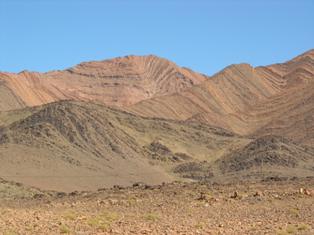
all backbone and ribs

with extraordinary colours reflected from weathered minerals.

The road snaked down the valley and provided an exhilarating ride. At our overnight stop at Tata, we were in great spirits. We ate a hearty Berber meal at a rambling hotel that was full of expeditioners heading into or out of the deserts of the south. These folk pay a lot of money to be squeezed into a Landrover or Landcruiser and be driven into the small patch of sand that Morocco calls a desert (it wouldnt qualify in most places) where they stay at a Berber Camp before returning to the comfort of the Tata hotel.
If we hadnt been so excited by the two days of amazing riding so far, we might have checked the weather report before making our next decision. With the sort of blissful ignorance that always precedes a beating, we decided to go north into the mountains again and to make for the village of Taliouine which is the centre of saffron production.
Our first leg was to revisit the village if Igherm, this time by a different, higher mountain pass. As we rumbled up through the hills we took this photo of a small oasis.

This was the last photo we took for the next day and a half. Twenty minutes after this we were climbing through the cloud base on a treacherously slippery switchback mountain road. It started to rain and didnt stop for the remainder of the day.
We stopped at a village café for hot coffee, and to put on more warm clothes and our outer waterproof suits (and to provide much entertainment for the locals). We pressed on through the mountains covering 45 km without getting out of third gear.
It was still raining when we arrived at Taliouine so we elected to leave the saffron cooperative to its own devices, find an omelette for lunch and get warm in our hotel. We ate dinner in our hotel still warm in our riding suits. We were finding out that Moroccans dont have much in the way of heating in their homes or hotels. It is simply too expensive. People just put on more clothing and put up with the cold. That night a German family staying at the same hotel came to dinner with a blanket from their room to keep warm in the icy dining room.
Into the Desert
If the Taliouine hotel had been warmer, we might have snuggled in with a novel and waited out the rain. As it was, this seemed like a second best option, so the next morning on went the nylon suits and we rolled the Elephant out onto the road.
By lunch we had reached the village of Agdz in the Draa Valley and had left the rain behind.

The village of Agdz was so pleased we were coming that they decked the town out in national flags. The visit by the King the previous week was merely incidental!
The fact that we were out of our rain suits, however, did not get us out of trouble. The winds that had brought rain and snow to the mountains blew itself out across the desert creating a dust storm that limited visibility and kept our helmet visors down. By the time we got to The Palmeraie Hotel at Zagora it was blowing hard and we were keen to get us and the bike indoors.

Like many hotels, The Palmeraie was happy for me to park the Elephant in its foyer

where we had to warn it not to fraternise with the mounts of some crazy Spanish cyclists.
When the dust settled the following day we decided that, having come this far south, we may as well go to the end of the road to the old caravan town of MHamid. The weather looked good, we felt good and the Elephant had had enough time with the cycles.

The Draa is Moroccos largest river and its valley is broad and dry with a thin line of green marking out the water course. A little further south, the river simply disappears into the desert sands only to reappear and find its way into the Atlantic just north of Tan Tan.

As we went further south, thatched fencing was used to stop the sand blowing across the road and

the desert came up to meet us.
When we arrived in MHamid we were surrounded by touts offering guides into the desert, Berber camp experiences and jeeps to take our luggage, before we had even switched off the ignition. So

we didnt switch off. We just headed out of town and went to find some desert ourselves.

Finally, we found a little shade and decided to boil the billy. Almost on cue, a bunch of Berbers turned up in a rat-arsed Renault R4 and offered to take us to their desert camp for a sleep-over. We sent them packing and were delighted when

they got stuck a little up the track. We reckoned that they were the desert experts, so we packed up and left them to it!

Down this way camels are still used for a lot of basic transport tasks. This train was heading off to re-supply a camp. While we found this fellow
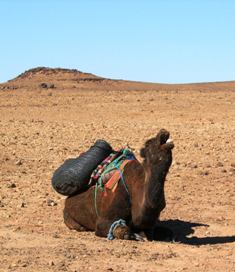
hobbled in the desert and waiting for his owner to come back from market.
Since both Jo and I have done our time sleeping under the stars in the freezing desert, we decided to leave the sandhills to the tourists and the touts and head north again to see if it had stopped raining on the mountains. Bike riders will understand this sentiment, others will just have to figure it out.
Into the Gorges
Next stop was El-Kelaa MGouna in the Dades Valley, also known as the Valley of a Thousand Kasbahs.
The town was packed for market day and we found a Berber wedding procession blocking one side of the road.
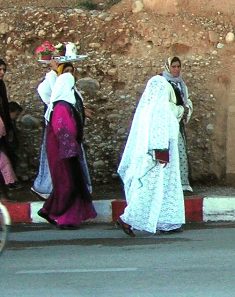
About 50 women with musical instruments paraded the bride along the street on the way to the ceremony.

Here in the south, where the population is nearly all Berber, we found women to be much more prominent in everyday life. They often spontaneously waved and smiled as we rode through the villages and they are engaged in commerce in one area or another. We didnt see this in the Arab north.

In El-Kelaa MGouna, we shared our overnight stop with a group of about 16 riders who had paid a kings ransom to spend a week riding dirt bikes in Morocco and following the Paris-Dakar. They had only been in country for one day and one rider already had an arm in a sling and they were all pissed-off about the cancellation of the rally. The Elephant wasnt interested in any skinny bummed KTMs, so we left them to it.

The road up into the mountains was another spectacular ride

always with the snow covered Atlas Mountains framed by the powder blue Moroccan sky.

We found many spectacular old kasbahs running up the fertile valley leading to the Dades Gorge.

And the higher we got, the more eerie they became against the snow covered mountains.
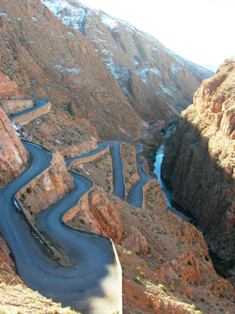
The gorge finally appeared at the head of the valley and the road clambered up in a series of impossible switchbacks. Through a narrow pass at the top, the road dropped away into a second valley beyond the gorge. Unfortunately this section got little sun and the snow and hard ice made it an unlikely prospect on the bike. We did a three point turn and headed back to the top of the pass

and the café at the top of the world for hot coffee

and a little route re-consideration.
We decided to do what we often do when faced with an impasse and went back down into the valley and found some lunch. In this case, our favourite lunch, the Berber Omelette.

These are made in a tajine and contain onions, skinned tomatoes, olives and saffron. Delicious!

We also thought the name of the restaurant was appropriate since Jos nephew, Christoph, has just become a father. His wife, Siobhan, gave birth to Ava on New Years Day.

Further east at the village of Tinerhir, the proprietor of the Oasis Hotel let us park the Elephant in the storeroom. I would recommend that anyone planning a trip like this spend some time practising riding their fully laden bike up stairs. It is a skill you will need!

Our last adventure in the south was a ride up the Todra Gorge. Jo had been in this area in 1971 and the only thing she remembered from that trip were the goats

and the goatherd she met. She reckoned that this eight year old

is probably the great grandson of the fellow she met in 71!
Perhaps the goat could be related to the one she saw back then; or perhaps not.

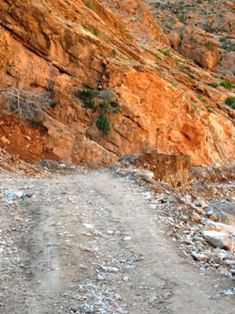
The road up the gorge had been washed out the year before so progress was slow. When we finally cleared the gorge and reached the last village


we found a group of Brits on BMWs and a KTM parked to clear mud from the back wheel of one of the bikes.

After the mandatory discussion on the benefits of shaft drive, we bid both the boys and the gorge farewell. We headed back to the bitumen and the road west to Ouarzazate and access to a pass over the High Atlas.
By the afternoon of 9 Jan the Elephant was parked on the veranda of another hotel and we were drinking red wine and talking about riding over the mountains into Marrakech.
This time we will check the weather report before we start!
